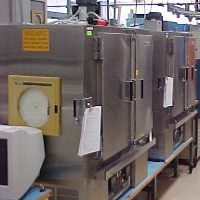Preconditioning Test
Integrated circuit preconditioning testing utilizes JESD22-A113, an industry standard test method, for the preconditioning sequence of non-hermetic solid state surface mount devices (SMDs) that are subjected to multiple solder reflow operations. With SMD preconditioning for reliability testing, SMDs are subjected to the appropriate integrated circuit preconditioning sequence prior to being submitted to specific long-term reliability testing.
Prior to subjecting the SMD part to the IC preconditioning test sequence, the device’s desired moisture sensitivity level (MSL) must be established. This MSL level will determine acceptable storage times for unsealed devices awaiting assembly. The IC preconditioning test should be performed at the highest temperature that the SMD is expected to encounter during the actual surface mount assembly process.
All non-hermetic SMDs submitted for IC preconditioning testing will go through the following sequence:
- Visual Inspection
- Temp Cycle – 5 cy (Optional)
- Bake – 24 hr. – 125 C
- Moisture Soak (view our Moisture Soak requirements)
- Reflow 3X
- Flux + Clean (see 3)
- Dry
- Test Specifications / Standards
- AEC-Q100
- AEC-Q101
- JESD22-A113
Note
Due to the trend of switching to Pb-free solder along with recent changes in JEDEC standards that apply to MSL and preconditioning testing, an explanation of the differences between MSL and pre-conditioning testing is warranted.
IPC/JEDEC J-STD-020D.1 is the standard used to initially identify the classification level of non-hermetic solid state surface mount devices (SMDs) that are sensitive to moisture-induced stress so they can be properly packaged, stored and handled to avoid damage during assembly. It is usually performed at two levels chosen to bracket the expected level of capability.
JESD22-A113F is the test method that establishes an industry standard preconditioning sequence for non-hermetic solid state surface mount devices (SMDs) that are subjected to multiple solder reflow operations. The SMDs should be subjected to the appropriate preconditioning sequence prior to being submitted to specific reliability testing to evaluate the long-term reliability.
The tests should be performed at the highest temperature that the SMD is expected to see during its actual assembly.




